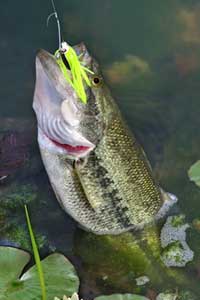Spinnerbaits

What are Spinnerbaits?
The ever popular, and universally loved spinnerbait comes in 2 basic shapes. The U or V shaped wire, and the Y shaped are the two major forms of this lure. And that’s it.
Their variety comes in the type of spinner, the bait used and the placement of other accessories.
Simply put, a spinnerbait is any fishing lure that has one or more metal blades shaped so as to spin like a propeller when the lure is in motion, flashing with the light reflecting off it’s surface.
The vibration that it gives off and the reflection of light is meant to closely resemble the movement and actions of a wounded prey fish.
Why are spinnerbaits so popular?
There’s many reasons for the universal acceptance of this lure. These are the 4 most common reasons.
- It can be fished in most any situation
- You can use almost any bait
- Spinnerbait will catch almost every freshwater fish found in North America
- They can be cast, trolled by the surface and the floor (although be careful with weeds as they can get caught up)
Safety Pin
The safety pin is also know as the overhead arm spinnerbait. It’s very popular with bass anglers and all the spinnerbaits on this page are of the safety pin variety.
Spinner Blade types
All blade types fall under the following categories:
Colorado blade: The Colorado blade is a round, spoon-shaped blade designed for maximum vibration. It has a broad shape and parabolic cross-section that creates a deep, heavy vibration that can be detected over long distances. Best for high turbidity waters and at night.
Willowleaf blade: The Willowleaf has a long, narrow blade and has an almost flat cross-section, which is know for its flash creation and very little vibration. Best for use in clear waters both during the day and at night.
Indiana blade: The Indiana blade is a hybrid of the Willowleaf and Colorado. It has the Willowleaf’s narrow width and Colorado’s rounded shape and a curved cross-section. The Indiana blade is best used with most in-line spinners.
Oklahoma blade: Also known as the turtleback, olympic, or mag willow, the Oklahoma is a short and rounded variant of the Willowleaf blade. It fits in between the Colorado and Indiana for vibration and rotation speed.
The Oklahoma blade is the best spinnerbait for largemouth and smallmouth bass and other aggressive bass.
Buzzbaits
For many anglers, buzzbaits is the term used for all spinnerbaits. We use the term to describe all spinnerbaits that have a bell-shaped, rotor blades.
Best use: Buzzbaits are just as they sound – fast. They’re designed for quickly catching fish or testing an area for fish.
 Single-Blade Spinnerbaits
Single-Blade Spinnerbaits
The single-blade spinnerbait is the most common spinner blade because it can be used most of the time.
The blade is usually attached to the upper arm. The exact location of the blade has a direct correlation to the lure’s performance.
When the blade is mounted on the clevis, it’s perfect for trolling as the blade will swing wide and create a greater audio profile.
Tip: Getting caught in the weeds can be avoided with a simple low-cost accessory. Take a small rubber band from the hook barb to the girth hitch.
Beetle Spin
In the 1990s, the Johnson Tackle Company introduce the clip-on jig/spinner designed for those who enjoyed the small jighead with soft plastic bodies.
The Beetle spin is not strictly a bass lure. It’s worked to catch many common sport fish in North America.
It has a small blade, a swivel and a wire frame with a spring clip. The jig is attached by sliding the jig eye so that the jig hook runs in the direction of the overhead blade.
Double-Blade Spinnerbaits
These are very good at waking up the fish as these lures create quite the racket.
There are 2 types of spinnerbaits. Double-blades can use 3 arms with the 2 upper arms adorned with spinners and the bottom one with the bait.
The other form uses a normal wire in U or Y form. The top arm has the spinner and the bottom arm the bait with the forward blade being mounted on the clevis.




